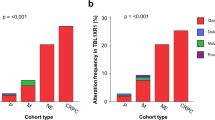Abstract
In a study of DNAs from 100 breast cancer patients and 100 controls, there were no differences in the frequencies of common or rare alleles at the Harvey ras (c-Ha-ras) locus on chromosome 11. However, one Ha-ras allele was deleted from the tumour DNA in 14 of 65 informative patients. Loss of a Ha-ras allele correlates with paucity of oestrogen receptor protein and with increased tumour size at presentation, but is not associated with microscopic evidence of lymph node invasion. The findings on Ha-ras and other informative loci are consistent with the possibility that a tumour suppressor gene involved in the early stages of breast cancer is located on the short arm of chromosome 11.
This is a preview of subscription content, access via your institution
Access options
Subscribe to this journal
Receive 24 print issues and online access
$259.00 per year
only $10.79 per issue
Buy this article
- Purchase on Springer Link
- Instant access to full article PDF
Prices may be subject to local taxes which are calculated during checkout
Similar content being viewed by others
Author information
Authors and Affiliations
Rights and permissions
About this article
Cite this article
Mackay, J., Elder, P., Porteous, D. et al. Partial deletion of chromosome 11p in breast cancer correlates with size of primary tumour and oestrogen receptor level. Br J Cancer 58, 710–714 (1988). https://doi.org/10.1038/bjc.1988.295
Issue Date:
DOI: https://doi.org/10.1038/bjc.1988.295
This article is cited by
-
Current evidence on the relationship between HRAS1 polymorphism and breast cancer risk: a meta-analysis
Breast Cancer Research and Treatment (2011)
-
Familial breast cancer and genes involved in breast carcinogenesis
Breast Cancer Research and Treatment (1995)
-
Molecular genetic studies of early breast cancer evolution
Breast Cancer Research and Treatment (1994)
-
Aberrations of theAPC gene in primary breast carcinoma
Journal of Cancer Research and Clinical Oncology (1994)
-
Characterization of four in vitro established canine mammary carcinoma and one atypical benign mixed tumor cell lines
In Vitro Cellular & Developmental Biology - Animal (1992)



